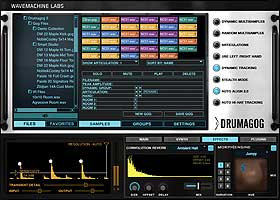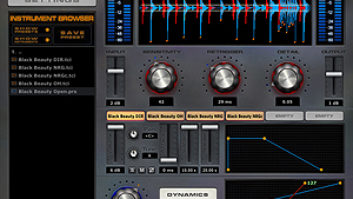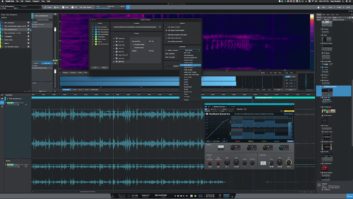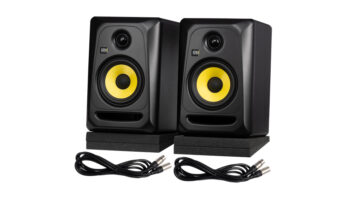
Version 5 of Wavemachine Labs’ drum-replacement software maintains the easy operation of past versions while adding new features and math under the hood, as well as introducing a redesigned GUI, all of which create a powerful, user-friendly production tool. This scalable software lets you opt for as much versatility as you can afford. I reviewed the full-throttle Drumagog 5 Platinum ($379) version, which includes many new extras. Next down the line is the Pro version ($289), then Drumagog 5 Basic ($149).
Drumagog 5 adds a convolution reverb, GUI redesign
and new Auto-Align functions.
DYNAMICALLY VERSATILE
One of Drumagog’s best features is its complexity of dynamic range and randomness. It features an unlimited amount of dynamic groups. The included “GOG” files preload different samples into each velocity step. Some of the included sets assign samples to a mere three or eight steps, while other more complicated sets work particularly well for drummers who play with a wider dynamic range as they are able to reproduce the greater variation in velocities. The real benefit is that one sample isn’t necessarily paired with each velocity cueing threshold, but with an entire group of samples. From there, Drumagog’s engine randomly plays one of the samples in that group corresponding to the velocity of the hit that is being replaced.
For example, one GOG file might contain five different quiet snare rattle sounds, five snare rattles with more stick attack, five medium snare cracks and five really hard whacks with the shell resonating. When replacing a snare hit of medium volume, any of the five medium hits might play. This way, even if the performance is very consistent in dynamics, always cueing the same threshold, no single sample will necessarily play over and over. The result is astonishingly realistic.
NEW FEATURES
Drumagog’s tracking engine was re-engineered in V. 5, which improved its accuracy. The software also incorporates an automatic phase-alignment feature (this was previously set by the user). Subtle frills and rolls were never neglected, and the phase-compensation engine seemed to work well. When blending original sounds with the sampled ones, they always seemed to add together well without having to adjust polarity or phase.
A new feature, Auto Hi-Hat Tracking, lets the plug-in automatically adjust in response to a hi-hat performance, gradually moving between open and closed articulations, and steps in between. I was impressed with the realistic feel this creates, although the whole engine seemed to track more slowly with the Auto Hi-Hat Tracking on, missing the detail of rolls on the hi-hat. The algorithm’s success will vary greatly based on the style of music involved. This feature also adds additional latency on top of the considerable latency that the plug-in imparts on its own.
The V. 5 GUI received a complete makeover and has a more polished and modern look. Thankfully, it no longer has pictures of drums being struck, which made it look like a toy. There’s a built-in convolution reverb and an effect called Morph|Engine. I’d rather add reverb to a drum mix outside of a single Drumagog instance, but Drumagog’s included reverb sounds are quite usable, if wanted. Morph|Engine is a filtering effect that makes drums sound more synthetic or electronic. While Morph|Engine’s interface is simple to grasp and easy to automate, it relies more heavily on presets than precise customizable controls; again, my personal inclination would be to use filters outside of this plug-in to achieve such effects. Sonically, Drumagog 5 adds room sounds to many of the GOG files, which greatly enhance the ability to sculpt the kit’s overall sound.
Drumagog 5 includes a generous library of different snares, toms, cymbals and kicks in a range of styles. There are good-sounding brushed snares, big meaty rock snares and electronic drum sounds that are all preconfigured into useful GOG files. And if you need to customize, building your own GOG files is simple and intuitive—although tedious—using the built-in editor. Drumagog 5 also offers plenty of powerful controls to fine-tune sounds to perfection, and the graphics make those controls very accessible. Be aware that Drumagog 5 is CPU-hungry and is recommended only for use with DAWs that have delay compensation.
I’d certainly recommend the Pro version, just for the sake of the Auto Align V. 2 engine and the pitch control. The main pluses for upgrading to Platinum are the Convolution Verb, Morph|Engine and Hi-Hat Tracking, and the ability to host any VST instrument within Drumagog and directly cue samples (such as BFD’s) using the Drumagog engine. Unless those are real draws, I’d say stick with the Pro version. I highly recommend Drumagog 5 as a comprehensive solution for drum replacement.
Brandon Hickey is an independent engineer and film audio consultant.

Click on the Product Summary box above to view the Drumagog 5 product page.







